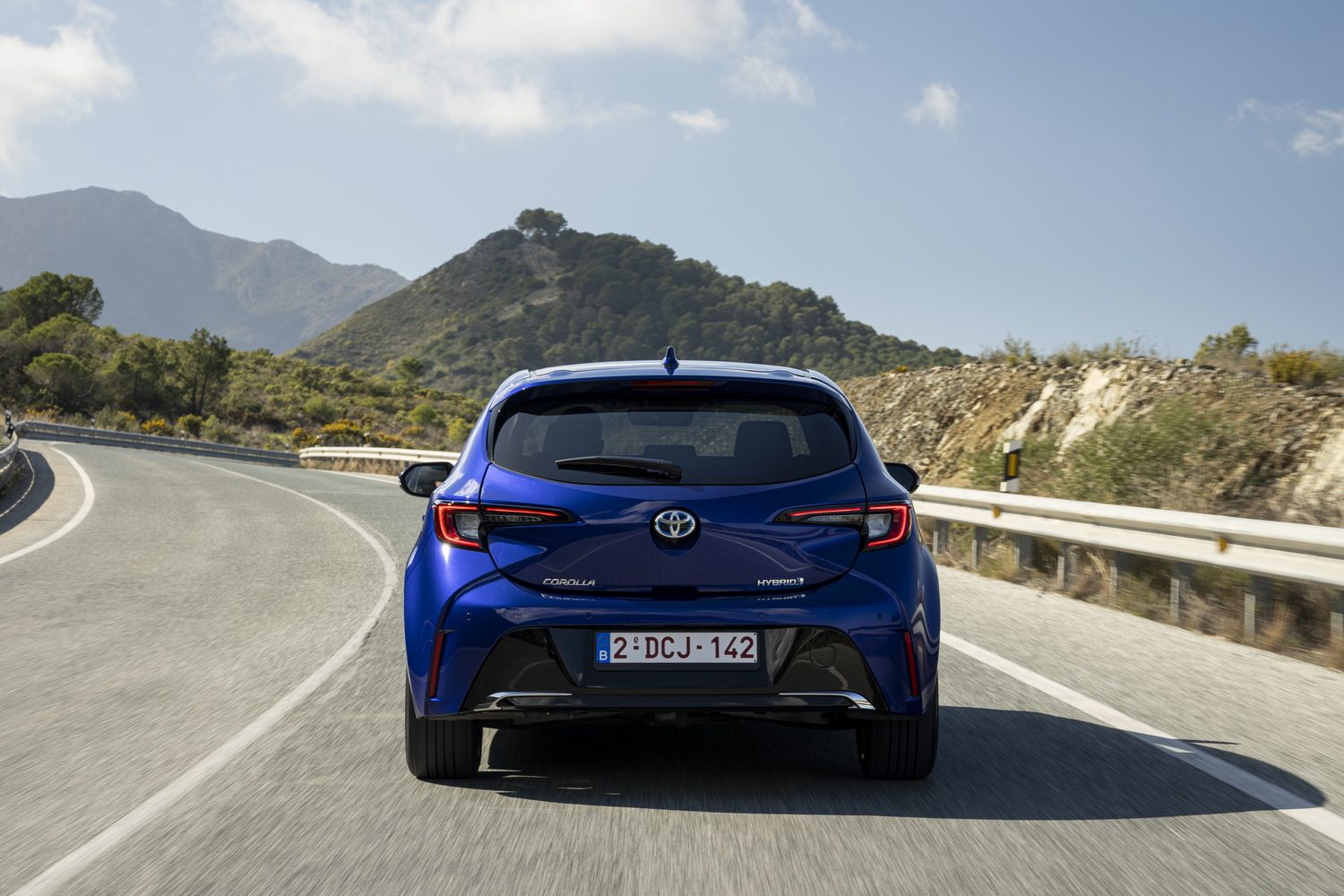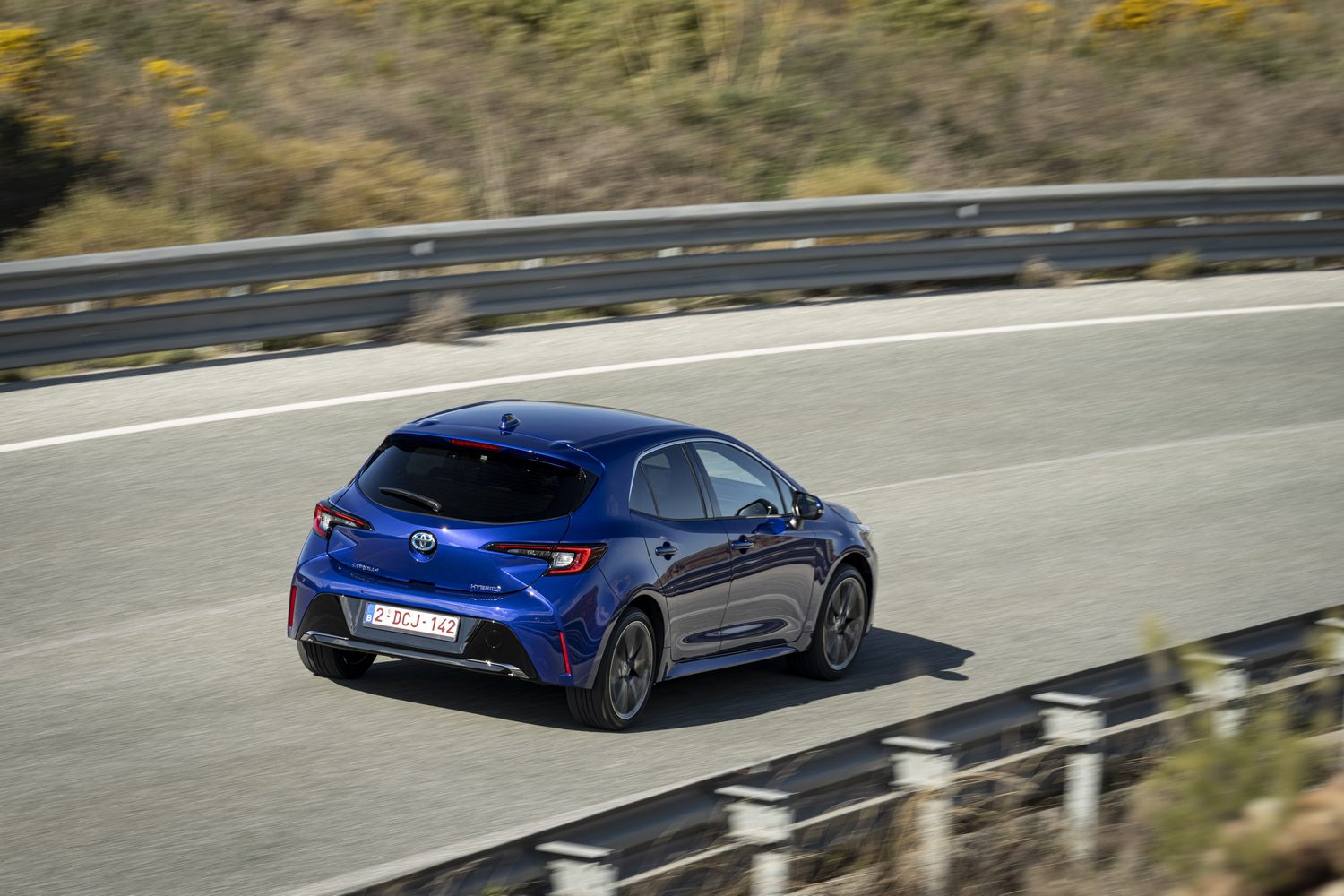Some 50 million sales on from the 1966 original, the Toyota Corolla, the world's favourite car, gets a series of minor - but useful - updates for 2023. Toyota's tweaks to the Corolla are broadly well done. The hybrid engine is improved, as is the cabin layout. Enough to hold back the SUV tide?
In the metal
Even Toyota Ireland admits that you'll have to be something of a card-carrying member (or anorak-wearing chairperson) of the Corolla Fan Club to spot the exterior differences between this latest version and the Corolla that was launched in 2019. It's a very, very subtle makeover, but perhaps that's what was needed - after all, the Corolla in hatchback form remains a handsome car and, according to Toyota, that's a major consideration for European car buyers.
There are new headlights (really just new LED innards in the same overall shape), a new front bumper and grille, some new alloy wheels (the 17-inch machined-look ones fitted to our test car are especially nice) and, around the back, a new bumper and tweaked brake lights. Our test car also came in a new colour - Juniper Blue - which is one of three new paint finishes available.
There are more significant changes inside. The old half-analogue, half-digital instrument pack has gone, and been replaced (as standard, across the range) by a new 12.3-inch digital instrument panel that looks exceptionally smart. Although its internal menu system is a little opaque at times, you can adjust the layout and content around to your liking. Meanwhile, if you flick the switch on the centre console to move from Sport to Normal to Eco modes, you get a dramatic side-on view of the car highlighted in different background colours.
In the centre of the dash, mounted up high, is a new 10.5-inch touchscreen for the infotainment system, which runs the impressive software that we've already seen in the likes of the Toyota Corolla Cross and sundry Lexus models. It's a vast, vast improvement on Toyota's old infotainment system, if perhaps still not quite a class-leading layout. The graphics are far more modern though, and the menu layout clearer and simpler.
Plus, it's now able to receive over-the-air software updates, and there's more connectivity for your phone, allowing you to do such things as flash the hazard lights to help you find your Corolla in a car park. Other new items include cloud-based navigation with live traffic updates (which can optionally be upgraded to a hard-drive based navigation system) and wireless Apple CarPlay and Android Auto. The Corolla's in-built internet connection is free for the first four years, incidentally.
Other cabin changes are minimal and restricted to trim items. For now, all Irish-bound Corollas will have simple black cabins, but there will eventually be the option of a pale beige finish. The Corolla continues to exude its abiding quality of, well, quality. Honestly, there are six-figure premium cars that don't feel as well bolted together as this humble family hatchback.
There are some quibbles though - the vast, jutting design of the passenger side of the dash eats into knee-room, while storage space up front is a touch tight. You get two cupholders, a storage area in front of the gear lever (fitted with an optional wireless charging pad in our test car), a bin under the armrest and reasonably roomy door bins, but there's not the nice 'open plan' effect you get in some rivals.
Equally, in this hatchback model, space in the back and in the boot is at something of a premium. Room in the rear seats is adequate, just about. In the boot, the situation is no better - even Toyota admits that the 361-litre space on offer is 'hardly class-leading' and when you fold the back seats down to liberate more storage space, there's a large step where the boot floor sits lower than the seat squabs.
It's worth mentioning the car's safety credentials here, as although the Corolla currently enjoys a full five-star EuroNCAP rating, Toyota has further tweaked and improved the car's safety package, under the name T-Mate. The forward-facing camera and radar have both been upgraded to remove a blind spot close to the front of the car and extend the detection range for a start. There's also an emergency steering assistant for the first time, and an improved traffic sign reading setup.
Driving it
The phrase that springs to mind here is 'relentless competency.' When launched in 2019, the Corolla shot straight to the top of the charts for driving appeal and sharpness, and while that edge has faded a touch in the intervening four years (and been in part usurped by the Mazda3 and updated Ford Focus), the Corolla remains a very satisfying car to drive indeed. If twisty roads are your thing, this hatchback model is the one to have as it sits on a slightly shorter wheelbase than the saloon and Touring Sports estate models (hence the reduced rear legroom) and so feels a smidge more adjustable and a little more agile when the road becomes truly challenging.
The 17-inch wheels of our test car are also the sweet spot of the range, and they don't overly compromise the ride quality, leaving the Corolla with a firm, but well-damped sensation over bumps. The steering is light, and not the last word in communication, but is accurate and there's plenty of front-end grip on offer should you need to adjust your cornering line. It's basically a very polished performer, easily capable of whipping up some driving enjoyment on the right road.
There's also an electronic helping hand - the new Progressive Driving Assistance system (PDA), which uses the forward-facing camera and radar to detect when you're about to enter a corner, or if there's a slower moving vehicle in front of you. If so, when you lift off the throttle, the PDA will ramp-up the electric motor's regenerative braking, giving you a slightly stronger braking effect, which slows you down and - helpfully - puts a little more charge into the battery. It's an unobtrusive system, and soon feels natural to use. Indeed, you can actually exploit it as a way of better-balancing the Corolla for a challenging corner.
Of course, that will matter little to most Corolla drivers. Indeed, we'd be surprised if many of them actually realise that there is a Sport mode, or ever bother to activate it. The Corolla's party trick is its efficiency, and the hybrid setup has been modified to make that even better.
The Corolla's 1.8-litre engine may be familiar from the 2019 model, but the electric half of the powertrain has been upgraded to what Toyota calls the fifth-generation hybrid . This means you get a beefier lithium-ion battery and an electric motor capable of providing more power. This means that the 1.8 hybrid's maximum horsepower has swollen by 18hp to 140hp, but there has been no effect at all on the official fuel economy nor emissions figures.
Once upon a time, any hybrid would have to be kept firmly in town if it were to achieve anything even vaguely like its official economy figures, but those days are long past. Toyota packed us off on a twisting, climbing, turning, dropping mountain road route that also included some fast motorway mileage and a bit of snarled-up urban driving. The result? Fuel consumption of 5.7 litres per 100km on average, which is extremely not bad, considering we were exploiting both Sport mode and that extra 18hp to the full at times.
In more normal driving, you should easily breach the 5.0 litres per 100km barrier, and Toyota's senior Corolla engineer, Ikuo Hayashi, reckons that thanks to the improved battery and motor, you should be able to do even more of your urban runs on electric power alone (previously claimed at up to 80 per cent of your journey, as independently verified by a UCD study). The only question mark over this is that we could swear we could hear the petrol engine idling in the background when the dashboard was telling us the car was in EV mode, but Toyota say that should not be possible (maybe it was just a lag in the EV indication light switching on and off).
Our test car's official CO2 rating was 102g/km, but you can get under 100g/km with the basic 16-inch wheels, meaning that, either way, you'll not be getting a massive motor tax bill each year.
The hybrid updates have also reduced the 'rubber band' effect of the CVT automatic gearbox, which more and more seems to mimic the actions of a dual-clutch transmission, albeit it 'shifts' more smoothly. On long uphill runs, the engine will still rev higher and longer than you'd ideally like, but the noise is reasonably well muted, and the engine's note isn't actually all that disagreeable.
For the most part, the Corolla is a quiet and refined drive, especially on the motorway where the hybrid updates have increased what the electric motor can contribute at higher speeds, and reduced the engine rpm for a given speed. The only refinement issue is tyre noise - there was quite a lot of rumble on most of the road surfaces we encountered, but it's worth noting that this hatchback model suffered in that regard less than the saloon and Touring Sports estate.
What you get for your money
Clearly, the price of everything has been going up of late, but it still seems - to this correspondent's addled brain - that discussing a Toyota Corolla with a base price of €32,530 is just a bit nuts. There is at least some compensation in the form of improved standard equipment, including the digital dials, the safety system upgrades, the connected infotainment, the cloud-based navigation and the improvements to the hybrid system and performance.
However, Irish Corolla buyers don't quite get the full safety system on offer - thanks to wrangling over standard equipment and what can physically be supplied, all but the GR Sport Corollas in this market miss out on front and rear parking sensors (although a reversing camera is standard on all models), and you can't get the blind-spot monitoring system, either. That also means we miss out on the front door opening warning that flashes and beeps if it reckons you're about to open your door into the face of an approaching cyclist or pedestrian. It means we can't get the rear crossing traffic alert system, either.
In fairness, on the price front, the base Corolla is only slightly more expensive than the most basic Volkswagen Golf, but comes with a much more powerful - and hybridised - engine, and a standard automatic transmission.
This Luna Sport model is expected to be the best-seller, but at €36,000 it's only really offering 17-inch alloys and heated front seats over and above the basic Luna version, so shop carefully. There is a top-spec GR Sport version, for €38,800, which gets sportier styling, 18-inch wheels and a unique digital instrument layout, but only a small percentage of Irish buyers are expected to plump for that one.
Summary
Given that (a), the Corolla has passed the 50 million sales mark in 2021, and (b), it sits in the top three for hatchback sales in almost all of the markets in which it competes (holding the No.1 spot in many, including Ireland), it should come as little surprise that Toyota has not made any dramatic changes to the Corolla. Ain't broke? Don't fix. That said, the hybrid upgrades have liberated a useful amount of extra performance, while the new digital instruments and infotainment system are welcome additions. We can't see the Corolla losing its top spot in Ireland any time soon.























